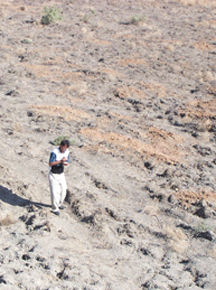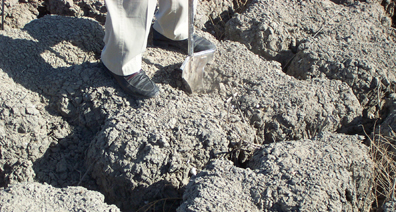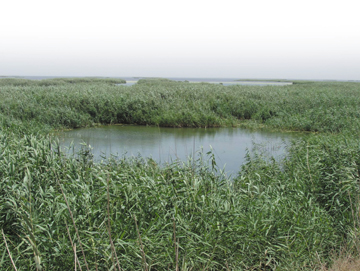Geotimes

Feature
Iraq’s Marshes
Renewed
Naomi Lubick
This summer, Western scientists visited Iraq’s marshlands for the first
time in decades. Though they had seen satellite images of the rapidly disappearing
wetlands, they could not completely assess their condition from afar. The images
showed that what once had been about 20,000 square kilometers of reeds, lakes
and ephemeral marshes had dwindled to 7 percent that size. Decades of dam and
canal building under Saddam Hussein’s regime had destroyed the marshlands;
data on water flow was unavailable. Now, under the auspices of the U.S. Agency
for International Development (USAID), geoscientists and others involved in
restoration efforts have had their first glimpses of what remains, in order
to plan for future restoration efforts.

 An Iraqi scientist checks the state of
Iraq’s desiccated Qurnah marsh (photographed last June). The central of
three Mesopotamian marshlands, it sits between the fork of the Tigris and Euphrates
rivers, north of the Hammar marsh, which is also dry; most of the 7 percent
of the region’s surviving marshlands are to the east in the Hawizeh marsh.
Photos courtesy of Suzie Alwash.
An Iraqi scientist checks the state of
Iraq’s desiccated Qurnah marsh (photographed last June). The central of
three Mesopotamian marshlands, it sits between the fork of the Tigris and Euphrates
rivers, north of the Hammar marsh, which is also dry; most of the 7 percent
of the region’s surviving marshlands are to the east in the Hawizeh marsh.
Photos courtesy of Suzie Alwash.
Azzam Alwash of the Eden Again project toured the marshes twice this summer.
He carries with him memories of visiting the Mesopotamian marshlands as a boy
with his father, who was a government hydrological engineer. Now trained himself
as a geotechnical engineer, Alwash’s first foray to the marshlands in decades
was to explore how to restore the now-desiccated region, as part of the USAID
team.
Alwash says he can only find good reasons to restore the marshes of Iraq: As
a cultural asset, the marshlands were home to Mesopotamian civilization and
the first sites of agriculture. Today, migrating birds use the marshes as a
way-station. Eden Again, a project Alwash started with his wife Suzie (also
a geologist), conducted interviews of some displaced Marsh Arabs, known as the
Ma’dan, who say they would like to see their home restored. They want to
raise water buffalo again and fish safely; such subsistence living produces
a majority of food sources for the region.
Last spring, planning for the day Iraq opened its borders to foreigners, Eden
Again released a report from an international collection of hydrologists and
marsh ecosystems experts, saying that restoration of the marshes was necessary
and possible. The Iraq Foundation, through a grant from the U.S. State Department,
has funded Eden Again, and the project recently received 1.2 million euros from
the Italian Ministry for the Environment and Territory, Alwash says.
Other organizations, from BirdLife International to Greenpeace, have shown interest
in such efforts. The AMAR International Charitable Foundation has actively assisted
the Marsh Arabs in Iran since 1991, in the context of restoration of the marshlands.
In partnership with USAID and the Coalition Provisional Authority, Iraq’s
Ministry of Water Resources has plans for six restoration sites in the marshlands
to be underway by the end of the year. USAID contracted with Development Alternatives,
Inc., based in Bethesda, Md., to look into initial efforts to restore the marshes.
Peter Reiss, a social anthropologist at the company, led the first trip this
summer to the marshes to see what improved management practices might be introduced,
he says, as well as the extent to which immediate restoration efforts might
be possible.
As head of USAID’s efforts, Reiss will lead the next trip to Iraq in October,
when the team will develop an action plan. Long-term restoration plans will
eventually stem from hydrologic flow models, built by the U.S. Army Corps of
Engineers with assistance from the U.S. Geological Survey, in addition to other
research. “Over the next year, we’ll have a better sense of how much
water is in the system and how much can be used,” Reiss says. He also hopes
to involve the United Nations’ Environmental Programme and Development
Programme — eventually incorporating as many organizations as possible
into the USAID marshlands program.
Some tribesmen who remain in the marshes have already taken matters into their
own hands, approaching government water managers after the Iraq war to open
the gates and let water flow into the area, according to Reiss. The USAID team
also saw several breached canals and dams, originally built by Saddam Hussein’s
regime to divert water from the Tigris and Euphrates rivers.
Uncontrolled breaches, however, might send large amounts of water into highly
saline areas, Alwash says, which could flow downstream, possibly flooding and
sterilizing remaining unspoiled marshland. If overly salty flow reaches the
Persian Gulf, he warns, it would create an environmental disaster for fish and
vegetation. That could prove disastrous to the major fisheries there, which
are already reduced by half, Reiss says. A wetter-than-usual winter season has
brought more flooding, in addition to excess water from dam releases in Iran,
Reiss explains.
“If something happens, then we will just have to deal with the consequences,”
Alwash says. Higher priorities for the Iraqi Authority, he says, include getting
potable water to cities and revitalizing agriculture in the region.
Alwash acknowledges that restoring the Mesopotamian marshes will add another
wrinkle to water conflicts brewing in the region, politically and culturally
(Geotimes, this issue). Water
once flooded the marshes annually, but now, Alwash says that Iraq “is a
water-poor country, and the culture has not yet caught up with that.” Traditional
Sumerian irrigation practices meant flooding fields. But damming upstream by
Turkey and Syria, to store the water in mountain reservoirs to the north, has
cut the seasonal spring floods to the marshes and elsewhere dramatically.
Thomas Naff, a Middle East water expert at the University of Pennsylvania in
Philadelphia, has catalogued more than 30 dams that have been built or planned
on the Tigris and Euphrates since the 1990s. Naff estimates that Turkey’s
southeast Anatolia project will cut water resources in Iraq by about half. Even
without Hussein’s dams and canals diverting water from Iraq’s marshlands,
Naff and his co-workers emphasize that past and future damming further upstream
in the region’s catchment basin also has the potential to dry out the marshes.
In addition to lack of water, the region suffers growing salinity problems from
past flooding in agricultural practices. Rising water tables, bottomed by thick
clay layers, push naturally saline water to the surface, where it evaporates
and leaves behind saltpan. The problem now makes efficient spray- and drip-irrigation
technologies seem economically feasible. But the Iraqi people do not have access
to or money for such practices, Alwash says, and these are long-term issues
beyond the scope of current potential restoration work.
Another important factor is that the region is a huge untapped oil reserve,
with working oil wells. Reiss says those areas “surely will be developed,”
which will benefit Iraqis, “but could be disastrous environmentally.”
Future oil industry decisions will have to take into account effects on the
marshes, he says (see story, Geotimes this
issue).
Curtis Richardson, director of the Duke University Wetland Center in Durham,
N.C., feels more positive about the marshlands’ future than he did before
he visited them as part of the USAID team in July. Until that trip, he and other
scientists advising the Eden Again project were relying on satellite maps and
hydrological data sometimes several decades old. Richardson now has about 100
soil and water samples he collected for testing from the Tigris and Euphrates
rivers, the results of which the team hopes to publish soon.
Despite the enthusiasm he witnessed for restoring the marshes this summer, Richardson
says that Iraq’s existing scientific capital is lacking. “Some very
good scientists at the University of Basra [have been] cut off since the 1970s,”
he says, barred from attending conferences or getting information outside Iraq.
“They have no real understanding of ecosystems management and science,
which is a new field that started in the 1970s,” Richardson adds.
Suzie Alwash says Eden Again will take the opportunity to engage in what she
calls “reciprocal capacity building.” Local Iraqi scientists can provide
information about flora and fauna, while international experts — including
Iraqi scientists returning from abroad — teach them ecosystems restoration
methods. Eden Again intends to hire Iraqis to carry out the restoration work,
in order to engage the stakeholders — and to sidestep the problems that
foreign workers may face in what remains a dangerous region. “The people
of Iraq need to make the decisions,” she says.
 Joy
Zedler, a wetlands ecologist from the University of Wisconsin at Madison, says
that local indigenous knowledge still exists. The wetlands “were not pristine
or undisturbed — they were highly occupied and tended systems. The people
that did that are still alive,” she says.
Joy
Zedler, a wetlands ecologist from the University of Wisconsin at Madison, says
that local indigenous knowledge still exists. The wetlands “were not pristine
or undisturbed — they were highly occupied and tended systems. The people
that did that are still alive,” she says.
Most surviving Iraqi marshland is concentrated
in the Hawizeh marsh, pictured here, which spills over the border into Iran.
Restoration efforts might begin with stabilizing these marshes — and using
them as a baseline for the entire ecosystem and its restoration. Photo courtesy
of Suzie Alwash.
Zedler, who made her comments as an advisor to the Eden Again project in the
spring, calls the Phragmites reeds that once served as backbone of much of the
marshes “the comeback kid,” which will make the process of restoration
somewhat easier. “If ever I wanted to guarantee I could create a wetland
quickly, I would pick a species like Phragmites,” Zedler says.
In the short-term, stabilizing the surviving Hawizeh marsh to the southeast
is Azzam Alwash’s priority. “Then increase the area by making more
water available,” Alwash says, using valuable water resources. The larger
questions of water policy and agricultural practices will be resolved later.
Hawizeh, he says, ultimately will serve as the Eden Again project’s baseline.
Alwash has seen that Iraq’s marshes still exist, and though not in their
former glory, he says, “there is hope.”
Lubick is a Geotimes
staff writer.
For more information on Iraq marsh restoration projects, visit the Eden
Again Project, sponsored by the Iraq Foundation, and the Duke
University Wetland Center.
Links
Water, Agriculture and Land Cover: Lessons
for the Postwar Era, Geotimes, October 2003
Assessing Iraq's Oil Potential, Geotimes,
October 2003
Back to top

 An Iraqi scientist checks the state of
Iraq’s desiccated Qurnah marsh (photographed last June). The central of
three Mesopotamian marshlands, it sits between the fork of the Tigris and Euphrates
rivers, north of the Hammar marsh, which is also dry; most of the 7 percent
of the region’s surviving marshlands are to the east in the Hawizeh marsh.
Photos courtesy of Suzie Alwash.
An Iraqi scientist checks the state of
Iraq’s desiccated Qurnah marsh (photographed last June). The central of
three Mesopotamian marshlands, it sits between the fork of the Tigris and Euphrates
rivers, north of the Hammar marsh, which is also dry; most of the 7 percent
of the region’s surviving marshlands are to the east in the Hawizeh marsh.
Photos courtesy of Suzie Alwash.
 Joy
Zedler, a wetlands ecologist from the University of Wisconsin at Madison, says
that local indigenous knowledge still exists. The wetlands “were not pristine
or undisturbed — they were highly occupied and tended systems. The people
that did that are still alive,” she says.
Joy
Zedler, a wetlands ecologist from the University of Wisconsin at Madison, says
that local indigenous knowledge still exists. The wetlands “were not pristine
or undisturbed — they were highly occupied and tended systems. The people
that did that are still alive,” she says.